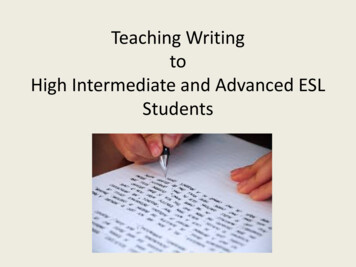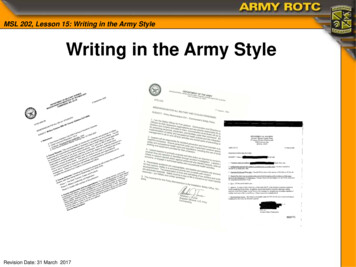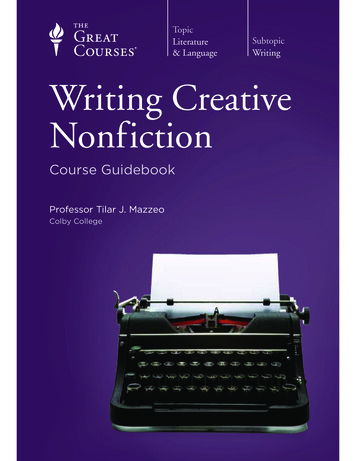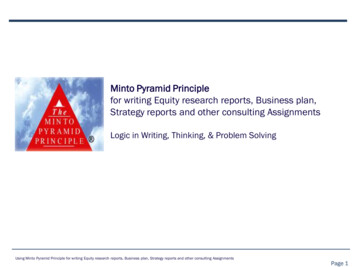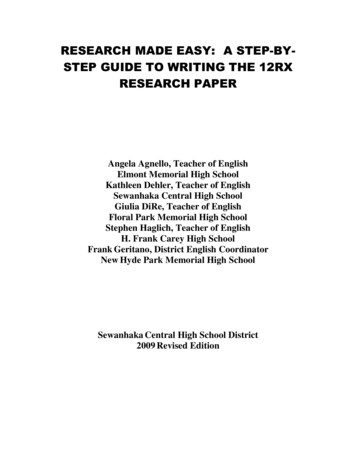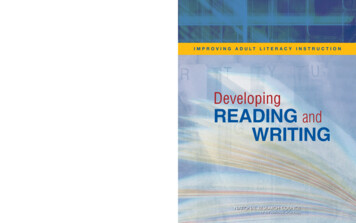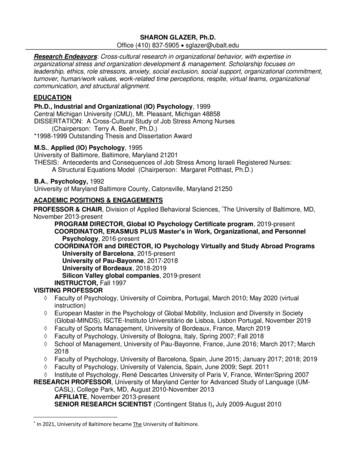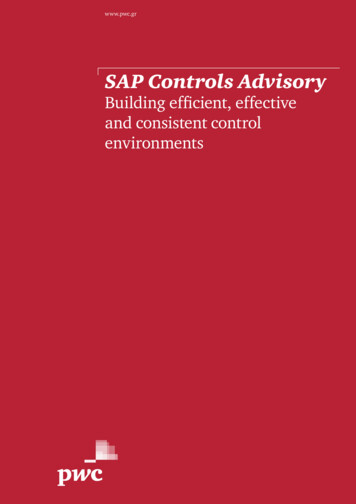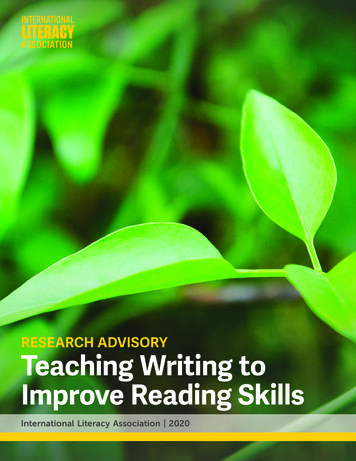
Transcription
RESEARCH ADVISORYTeaching Writing toImprove Reading SkillsInternational Literacy Association 2020
RWriting and the teachingof writing enhance not onlystudents’ comprehensionand flu ency when readingbut also their recognitionand decoding of wordsin text.eading is seen by many as an essential ingredient forlearning to write. American author William Faulkneradvised that the road to good writing is to “read, read,read.” English poet and critic Samuel Johnson advocated that one must turn over half of a library in order to writea single book. Novelist Toni Morrison argued that writing requires learning to read your own work critically.These esteemed authors were not mistaken. Reading contributes to learning how to write. Scientific evidence providesample support for this vital contention. Elementary and secondary students become better writers by reading as well asby analyzing text. For example, when teachers guide studentsin the analysis of mentor texts, students better understand thepurposes and construction of specific genres, including theattributes of strong writing (e.g., ideation, organization, wordchoice, sentence fluency, voice). This knowledge provides students with schemas that help them read as well as produce better text.Is this relationship between reading and writing reciprocal?Does the path to better reading involve becoming a good writer?The answer to these questions presents a paradox. One does nothave to learn to write in order to learn to read, as learning howto write or type words in order to read them is not necessary.Even so, writing and the teaching of writing contributes to students’ growth as readers. Collectively, writing and the teachingof writing enhance not only students’ comprehension and fluency when reading but also their recognition and decoding ofwords in text.1This connection makes writing an essential ingredient inlearning to read. “Write, write, write and teach writing” mustbecome a more integral part of the equation. We use writingto communicate, persuade, learn, record information, createimaginary worlds, express feelings, entertain, heal psychological wounds, chronicle experiences, and explore the meaning ofevents and situations.Let Students Write“Writing is really fun!”This second grader’s enthusiasm for writing is not misplaced.The more students write, the better they become at creatingtheir own text.22
Creating text for others toread provides students withoppor tunities to becomemore thoughtful andengaged when reading.Creating text for others to read provides students with opportunities to become more thoughtful and engaged when reading.When students create text, they need to follow the rules of logicand make their assumptions and premises explicit to their audience. This makes students more aware of these same issueswhen reading text.Writing also allows students to become more comfortablewith the act of writing and to hone their skills as writers. Asstudents write, they learn by doing. They try out differentforms of writing, apply different strategies and approaches forproducing text, and gain fluency with basic writing skills suchas handwriting, spelling, and sentence construction.In the elementary grades, students should write for at least30 minutes a day, and they should write for even longer periodsin middle school and high school. Students’ writing in middleand high school should be across the subject areas and shouldinclude longer and shorter writing tasks (e.g., brief response toreading or a report on a specific topic synthesis). The effects ofwriting are more likely to be maximized if students write forreal purposes and audiences. To master specific forms of writing, students need multiple opportunities to practice each typeof text.Let Students Write About What TheyReadWriting about material students have read enhances theircomprehension and retention.3 Writing can facilitate students’comprehension of text through the following: Fostering explicitness Promoting integration of information Creating a personal involvement with text Encouraging thinking about ideas Facilitating new understandingsA range of effective writing activities can be used to improvestudents’ comprehension of text, such as the following: Writing answers to teacher-posed questions about text Creating and answering in writing personal questionsabout text3
Taking notes about material read Creating a brief written summary of the text Producing a written story about the material read Describing in writing how to apply ideas from text Building an argument to support or refute ideas presentedin textStudents can begin using writing as a tool to support comprehension and learning as early as first grade. Teachers shoulddescribe the writing activity and its purpose and demonstratehow to use it. For many writing activities, such as summarization, students need additional guided practice.Attention should also be devoted to helping students learn touse the same writing activity across subjects. For example, students typically apply the same structural elements (e.g., claims,grounds, warrants, supports, rebuttals, qualifications) whenbuilding an argument to support or reject an idea presented inan English, a science, or a social studies text. Even so, these elements of argumentation do not appear in the same form or tothe same degree in each of these subject areas.Teach Writing“I now know how to do it. Someone taught me.”Although writing andreading are not identicalskills, they each drawon common sources ofknowledge.Reading and writing are complex activities. Both involve multiple skills and processes. As this comment by a fourth graderillustrates, students benefit when they are taught how to readand write.4Why does writing instruction lead to better reading (and viceversa)? Although writing and reading are not identical skills,they each draw on common sources of knowledge. Readersdraw on their knowledge of words, syntax, usage, and the features of text to decode words and comprehend sentence andlonger pieces of text. Writers use this same knowledge to spellwords, craft sentences, and create compositions.Readers apply what they know about the functions and purposes of written language to help them interpret an author’smessage. Writers draw on this same knowledge to help themconstruct their own text for others to read. Readers use theirknowledge of goal setting, accessing information, questioning,predicting, summarizing, visualizing, and analyzing to make4
The effects of writinginstruction on readingdepend on how well writingskills or processes aretaught and whether theyenhance one or more ofthe common sources ofknowledge.sense of what is read. Writers take advantage of this same information as they orchestrate and construct their writing.5In the elementary grades, at least 30 minutes a day should bedevoted to teaching writing. In middle school and high school,the time devoted to writing varies depending on how frequentlyteachers in different subjects use writing as a tool for learning.The effects of writing instruction on reading depend on howwell writing skills or processes are taught and whether theyenhance one or more of the common sources of knowledgepreviously described: words, syntax, usage, and text features;functions and purposes of written language; and strategic processes for creating and interpreting text.Help Students Master the Process ofWriting“Writing, working, worrying, wondering, who knows, and help.”These were the processes a journalism student identified forwriting a newspaper article when asked about the “five Ws andone H” of journalism. The correct answers to this test item are,however, who, what, when, where, why, and how. These processesprovide students with a strategy to remind them that they needto cover all the basic elements when writing a newspaper story.The process of writing typically involves planning, drafting,revising, and editing: Planning includes setting rhetorical goals as well as gathering and organizing information to meet these objectives.Plans guide writers as they draft their paper but are bestviewed as temporary guides that may be abandoned, expanded, or reworked during writing. Drafting involves using the planned ideas, knowledge ofsyntax, orthography, and genre to construct sentences.When plans are clear and well designed, sentence construction is supported. Typing and writing fluency can affect productivity and quality of the written message. Revising focuses on evaluating and modifying plans, text,or both as needed. Editing targets the correction of mechanical, spelling,grammar, and other types of errors in text.5
When students are taughthow to engage in theprocess of writing,their compositionsbecome longer, full, andqualita tively better.These processes are recursive and can occur at any pointduring writing. Writers often use strategies specific to a particular form of writing when carrying out writing processes,such as the “five Ws and one H” strategy described earlier inthis section.Learning how to navigate the writing process is not something that happens immediately. It requires a gradual releaseof responsibility from teacher to students. When learning howto plan, draft, revise, and edit their work, students need to seeteachers model these processes. Modeling by thinking out loudmakes these processes visible and audible to students. Then,as students practice how to apply these processes in wholegroup and small groups with guided support, students becomeequipped with the necessary knowledge to plan, draft, revise,and edit text effectively.When students are taught how to engage in the process ofwriting, their compositions become longer, full, and qualitatively better.6 Such instruction helps students develop proficiency in the basic thinking processes underlying writing,including the following: Setting goals Accessing, organizing, and summarizing information Predicting what readers need to know Questioning, analyzing, evaluating, and making decisions Modifying plans and ideas as neededTeaching students specific strategies for composing a particular type of writing has the added benefit of providing themwith information about the purposes and features of such text: Who are the main characters? What are their motivations? Where does the story take place? When does the story occur? What do the main characters want? What happens as they try to achieve their objectives? How does the story end? How do the main characters react to these events?6
Strategies such as these are taught by explaining and discussingtheir purposes, modeling how to use them, providing guided practice in their application, and helping students learn to apply themin a thoughtful and flexible manner.To make sense of what is read, students rely on many of the samemental operations applied when writing, including setting goalsfor reading, accessing information from memory, summarizingmaterial in text, and analyzing, evaluating, and rethinking whatis read.7Make Sure Students Spell Correctly“Then the Spanish gorillas came down from the hills and nipped atNapoleon’s flanks.”The impact of spell ingextends beyond a writer’saudience and involves thewriter as well.Misspellings like the one in this brief description of Napoleon’sSpanish Wars can lead readers to question the accuracy of themessage as well as the wisdom of the writer. The impact of spelling extends beyond a writer’s audience and involves the writer aswell. Having to think about how to spell a word when writing canlead students to forget ideas held in memory and not yet committed to paper. It can also lead students to choose a different wordthat they already know how to spell, restricting word choice in students’ writing.Teaching students how to spell not only makes them betterspellers but also enhances multiple reading skills.8 Phonologicalawareness is improved when young students study how a word isspelled. The examination of how sounds and letters fit togetherin spelling words provides cues about the phonemic structure ofwords to be read.Phonics skills are strengthened when students are taught thatparticular sounds stand for specific letters. This increases students’ knowledge about the alphabetic principles involved in reading words. Word reading becomes more accurate and fluent whenstudents learn how to spell individual words. This additional practice with spelling words makes it easier to recognize them whenreading. These gains in word reading and fluency lead to improvedcomprehension of text.Contemporary spelling instruction includes two fundamentalpractices that positively impact students’ reading and spelling:(a) teaching students how to spell words or spelling patterns theyfrequently use when writing and encounter when reading and (b)extending students’ understanding of the spelling system through7
word study. Instructional procedures such as word sorting (analyzing spelling words to determine their spelling pattern; e.g.,map and make) and word building (building as many words aspossible from a specific spelling pattern such as at) strengthenstudents’ knowledge of spelling and reading.Show Students How to Turn Ideas IntoSentences“Grammar is what the teachers learn us.”Teaching students howto write more complexsentences has an additionalbenefit: Students becomemore fluent readers.Students spend much of their writing time converting ideas intosentences that should be grammatically correct, make sense,and use the right words to convey a their intended meanings.As with spelling, sentence mishaps like the one in this openingquote color readers’ perceptions of the message and the acumen of the writer.Constructing written sentences is a complex process involving decisions about word choice, syntax, textual connections,clarity, and rhythm. A limited knowledge about how to construct written sentences diminishes students’ success in translating their thoughts into text and imposes a heavy mental loadon students, as they are still developing voluntary control overwritten sentence production processes. Teaching students howto construct written sentences reduces grammatical miscues,increases sentence complexity, and results in qualitatively better text.Teaching students how to write more complex sentences hasan additional benefit: Students become more fluent readers.As students practice producing specific types of written sentences, they gain familiarity and facility with the syntacticalstructures underlying each of them. This increased recognitionof sentence patterns allows students to process information insimilar sentences they are reading more quickly.9Written sentence construction can be effectively taughtusing sentence combining. With this approach, the teachermodels how to combine two or more simple sentences into asingle complex sentence. This can include providing studentswith cues about which words should be used to combine sentences (e.g., although) and can further involve highlighting thewords in the sentences that must be retained when creating anew sentence from them. Students practice combining simple8
sentences into the more complex pattern until they can do thiscorrectly and easily. They should be encouraged to use newlymastered sentence construction skills when writing and revising text.Teach Reading and Writing Together“I learned early in life that you can be a reader or writer. I decided to be a writer.”When reading and writingreceive equal emphasisin literacy instruction,students become betterreaders and writers.This missive from Erskine Caldwell, an American novelist, isprovocative but not correct. Students can become good writers as well as good readers. When reading and writing receiveequal emphasis in literacy instruction, students become betterreaders and writers.10 They become more adept at decodingand understanding individual words and comprehending text.Further, they write qualitatively better text that is longer andcontains fewer errors.Do Reading and Writing Always Needto Be Tied Together?The answer to this question is no. Students need time just toread. They do not need to write about everything they read. Infact, this would take much of the joy out of reading, making itand writing a chore.Students also need time just to write. Writing activities suchas creating a story or personal narrative, expressing feelings,chronicling experiences, exploring the meaning of experiencesand events, and using writing as a tool for learning do not needto be preceded by reading.There are many effective practices for teaching writing thatneed to be part of a strong literacy program, but they do notneed to be tied directly to the teaching of reading. This includesestablishing specific goals for students’ writing, encouragingstudents to work together when composing, providing feedback on students’ papers, teaching handwriting and keyboarding skills, engaging students in prewriting activities, and usingdigital and multimodal tools for writing.Likewise, not all reading practices need to be tied directlyto the teaching of writing. For instance, effective practices forpromoting reading fluency involve reading and not writing.Although writing can be used to promote students’ thinking9
about material they are reading, so can oral discussion andother modes of expression such as drawing, music, or physicalmovement.Overall, writing and reading share many similarities butare not identical. Reading and reading instruction can improve writing and writing and writing instruction can improvereading. The goal is to provide time for their instruction, opportunities for integration, and authentic purposes for theirapplication.BIBLIOGRAPHYAdams, M.J. (1990). Beginning to read: Thinking andlearning about print. MIT Press.Andrews, R., Torgerson, C., Beverton, S., Freeman,A., Locke, T., Low, G., Zhu, D. (2006). The effect ofgrammar teaching on writing development. BritishEducational Research Journal, 32(1), 39–55.Applebee, A.N. (1984). Writing and reasoning. Review ofEducational Research, 54(4), 577–596.Bangert-Drowns, R.L., Hurley, M.M., & Wilkinson, B.(2004). The effects of school-based writing-to-learninterventions on academic achievement: A metaanalysis. Review of Educational Research, 74(1), 29–58.Bazerman, C. (Ed.). (2008). Handbook of research on writing: History, society, school, individual, text. Routledge.Berninger, V.W. (1999). Coordinating transcription andtext generation in working memory during composing: Automatic and constructive processes. LearningDisability Quarterly, 22(2), 99–112.Ehri, L.C. (2000). Learning to read and learning to spell:Two sides of a coin. Topics in Language Disorders,20(3), 19–36.Fitzgerald, J., & Shanahan, T. (2000). Reading and writing relations and their development. EducationalPsychologist, 35(1), 39–50.Foorman, B., Beyler, N., Borradaile, K., Coyne, M., Denton,C.A., Dimino, J., Wissel, S. (2016). Foundational skillsto support reading for understanding in kindergarten through 3rd grade (NCEE 2016–4008). NationalCenter for Education Evaluation and RegionalAssistance (NCEE), Institute of Education Sciences,U.S. Department of Education.Galbraith, D., & Baaijen, V.M. (2018). The work of writing:Raiding the inarticulate. Educational Psychologist,53(4), 238–257.Graham, S. (2019). Changing how writing is taught.Review of Research in Education, 43(1), 277–303.Graham, S., Bollinger, A., Olson, C.B., D’Aoust, C.,MacArthur, C., McCutchen, D., & Olinghouse, N.(2012). Teaching elementary school students to be effective writers (NCEE 2012-4058). National Centerfor Education Evaluation and Regional Assistance,Institute of Education Sciences, U.S. Department ofEducation.Graham, S., Harris, K.R., & Hebert, M. (2011). It is morethan just the message: Presentation effects in scoringwriting. Focus on Exceptional Children, 44(4), 1–12.Kellogg, R.T., & Whiteford, A.P. (2009). Training advanced writing skills: The case for deliberate practice.Educational Psychologist, 44(4), 250–266.10
Klein, P.D. (1999). Reopening inquiry into cognitive processes in writing-to-learn. Educational PsychologyReview, 11(3), 203–270.Klein, P., & Boscolo, P. (2016). Trends in research on writing as a learning activity. Journal of Writing Research,7(3), 311–350.Koster, M., Tribushinina, E., de Jong, P.F., & van denBergh, H. (2015). Teaching children to write: Ameta-analysis of writing intervention research.Journal of Writing Research, 7(2), 249–274.Langer, J.A. (1986). Children’s reading and writing:Structures and strategies. Ablex.Langer, J.A., & Applebee, A.N. (1987). How writing shapesthinking: A study of teaching and learning. NationalCouncil of Teachers of English.Lederer, R. (1987). Anguished English: An anthology of accidental assaults upon our language. Dell.Linkletter, A. (1965). A child’s garden of misinformation.Random House.McCutchen, D. (1996). A capacity theory of writing:Working memory in composition. EducationalPsychology Review, 8(3), 299–325.National Institute of Child Health and HumanDevelopment. (2000). Report of the National ReadingPanel. Teaching children to read: An evidence-basedassessment of the scientific research literature on reading and its implications for reading instruction (NIHPublication No. 00-4769). U.S. Government PrintingOffice.Nelson, N., & Calfee, R.C. (1998). The reading-writing connection. In K. Borman & B. Schneider (Eds.),Ninety-seventh yearbook of the national society for thestudy of education (Part II, pp. 1–52). National Societyfor the Study of Education.Neville, D.D., & Searls, E.F. (1991). A meta-analytic review of the effect of sentence-combining on readingcomprehension. Reading Research and Instruction,31(1), 63–76.Philippakos, Z.A. (2018). Using a task analysis processfor reading and writing assignments. The ReadingTeacher, 72(1), 107–114.Philippakos, Z.A., & MacArthur, C.A. (2016). The effectsof giving feedback on the persuasive writing of fourthand fifth-grade students. Reading Research Quarterly,51(4), 419–433.Plimpton, G. (1999). The writer’s chapbook: A compendium of fact, opinion, wit, and advice from the twentiethcentury’s preeminent writers. Modern Library.Rijlaarsdam, G., van den Bergh, H., Couzijn, M., Janssen,T., Braaksma, M., Tillema, M., Raedts, M. (2012).Writing. In K.R. Harris, S. Graham, & T. Urdan (Eds.),APA educational psychology handbook (Vol. 3, pp. 189–227). American Psychological Association.Santangelo, T., & Graham, S. (2016). A comprehensivemeta-analysis of handwriting instruction. EducationalPsychology Review, 28(2), 225–265.Schappel, E., & Lacour, C.B. (1993, Fall). Toni Morrison,the art of fiction No. 134. The Paris Review. risonShanahan, T. (2006). Relations among oral language,reading, and writing development. In C.A. MacArthur,S. Graham, & J. Fitzgerald (Eds.), Handbook of writingresearch (1st ed., pp. 171–183). Guilford Press.Shanahan, T. (2016). Relationships between reading andwriting development. In C.A. MacArthur, S. Graham,& J. Fitzgerald (Eds.), Handbook of writing research(2nd ed., pp. 194–207). Guilford Press.Smagorinsky, P. (1995). Constructing meaning in the disciplines: Reconceptualizing writing across the curriculum as composing across the curriculum. AmericanJournal of Education, 103(2), 160–184.Smagorinsky, P., & Mayer, R.E. (2014). Learning to be literate. In R.K. Sawyer (Ed.), The Cambridge handbookof learning sciences (2nd ed., pp. 605–625). CambridgeUniversity Press.Tierney, R.J., & Shanahan, T. (1991). Research on thereading–writing relationship: Interactions, transactions, and outcomes. In R. Barr, M.L. Kamil, P.Mosenthal, & P.D. Pearson (Eds.), Handbook of readingresearch (Vol. 2, pp. 246–280). Longman.Winokur, J. (1987). Writers on writing (2nd ed.). RunningPress.11
NOTESinterventions on writing. Review of EducationalResearch, 88(2), 243–284.6Graham, S., McKeown, D., Kiuhara, S., & Harris,K.R. (2012). A meta-analysis of writing instructionfor students in the elementary grades. Journal ofEducational Psychology, 104(4), 879–896.7Graham, S., & Hebert, M. (2011). Writing to read:A meta-analysis of the impact of writing and writing instruction on reading. Harvard EducationalReview, 81(4), 710–744.8Graham, S., & Santangelo, T. (2014). Does spellinginstruction make students better spellers, readers, and writers? A meta-analytic review. Readingand Writing: An Interdisciplinary Journal, 27(9),1703–1743.9Graham, S., & Hebert, M. (2011). Writing to read:A meta-analysis of the impact of writing and writing instruction on reading. Harvard EducationalReview, 81(4), 710–744.10Graham, S., Liu, X., Aitken, A., Ng, C., Bartlett, B.,Harris, K.R., & Holzapfel, J. (2018). Effectivenessof literacy programs balancing reading andwriting instruction: A meta-analysis. ReadingResearch Quarterly, 53(3), 279–304.The recommended instructional procedures forpromoting reading and writing were drawn frommeta-analyses of scientific studies where writing, reading, or both were taught.2Graham, S., & Hebert, M. (2011). Writing to read:A meta-analysis of the impact of writing and writing instruction on reading. Harvard EducationalReview, 81(4), 710–744.3Graham, S., & Hebert, M. (2011). Writing to read:A meta-analysis of the impact of writing and writing instruction on reading. Harvard EducationalReview, 81(4), 710–744.4Graham, S., & Hebert, M. (2011). Writing to read:A meta-analysis of the impact of writing and writing instruction on reading. Harvard EducationalReview, 81(4), 710–744; Graham, S., McKeown, D.,Kiuhara, S., & Harris, K.R. (2012). A meta-analysisof writing instruction for students in the elementary grades. Journal of Educational Psychology,104(4), 879–896.5Graham, S., Liu, X., Bartlett, B., Ng, C., Harris,K.R., Aitken, A., Talukdar, J. (2018). Reading forwriting: A meta-analysis of the impact of reading112
International Literacy Association Task Force on WritingChairZoi A. Traga Philippakos, University of Tennessee, KnoxvillePrincipal AuthorsZoi A. Traga Philippakos, Assistant Professor, University of Tennessee, KnoxvilleSteve Graham, Mary Emily Warner Professor, Arizona State UniversityContributing MembersLori Assaf, Texas State UniversitySarah W. Beck, New York UniversityErin FitzPatrick, University of North Carolina at CharlotteCharles A. MacArthur, University of DelawareEmily Machado, University of WashingtonKristen Pennycuff Trent, Tennessee TechKathy N. Headley, Clemson University, President and Board Liaison, International Literacy AssociationBernadette Dwyer, Dublin City University, Ireland, Immediate Past President, International Literacy AssociationStephen Peters, Laurens County School District 55, Vice President, International Literacy AssociationMarcie Craig Post, Executive Director, International Literacy Association 2020 International Literacy Association No. 9462This research advisory is available in PDF form for free download through the International Literacy Association’s website:literacyworldwide.org/statements.Media Contact: For all media inquiries, please contact press@reading.org.Suggested APA ReferenceInternational Literacy Association. (2020). Teaching writing to improve reading skills [Research advisory]. Newark, DE: Author.About the International Literacy AssociationThe International Literacy Association (ILA) is a global advocacy and membership organization dedicated to advancing literacyfor all through its network of more than 300,000 literacy educators, researchers, and experts across 146 countries. With over60 years of experience, ILA has set the standard for how literacy is defined, taught, and evaluated. ILA’s Standards for thePreparation of Literacy Professionals 2017 provides an evidence-based benchmark for the development and evaluation ofliteracy professional preparation programs. ILA collaborates with partners across the world to develop, gather, and disseminatehigh-quality resources, best practices, and cutting-edge research to empower educators, inspire students, and informpolicymakers. ILA publishes The Reading Teacher, Journal of Adolescent & Adult Literacy, and Reading Research Quarterly,which are peer reviewed and edited by leaders in the field. For more information, visit onalLiteracyAssociationliteracyworldwide.org13
spellers but also enhances multiple reading skills.8 Phonological awareness is improved when young students study how a word is spelled. The examination of how sounds and letters fit together in spelling words provides cues about the phonemic structure of words to be read. Phonics skill
